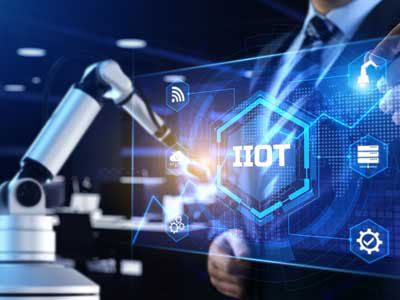Key Takeaway
The future of the Industrial Internet of Things (IIoT) is promising. Small businesses and global companies will benefit from cost-saving predictive maintenance and enhanced communication between devices. Improved affordability will make IIoT access easier for more facilities, leading to better connectivity and efficiency. As technology advances, IIoT will enable smarter, more responsive industrial operations. Factories will run smoother, energy use will be optimized, and supply chains will become more transparent. Overall, the IIoT will drive significant improvements in productivity, cost savings, and innovation, transforming how industries operate and compete.
Emerging Technologies and Innovations
The Industrial Internet of Things (IIoT) is transforming how industries operate by integrating advanced technologies. We see innovations like edge computing, which brings data processing closer to the source, enhancing speed and efficiency. Artificial Intelligence (AI) and Machine Learning (ML) are being integrated into IIoT systems, enabling predictive maintenance and smarter decision-making. Additionally, 5G networks are providing the necessary bandwidth and low latency for seamless connectivity between devices. These technologies are not just buzzwords; they’re actively reshaping the industrial landscape by enabling real-time data analytics and improved operational efficiency.

Market Trends and Growth Projections
The IIoT market is experiencing a surge, driven by smart manufacturing and automation. According to analysts, the global IIoT market is set to reach $1.1 trillion by 2028, growing at a CAGR of 24.7% from 2021 to 2028. Industries like manufacturing, energy, and transportation are leading adopters, using IIoT to boost productivity and cut costs. The demand for data-driven insights and enhanced security measures is fueling this growth. As companies realize IIoT’s value, investments and innovations in this field are expected to rise significantly.
The rapid growth of IIoT brings exciting opportunities and challenges. Cybersecurity remains a key concern with more devices connected to the internet, increasing the risk of cyber attacks. Integrating legacy systems with modern IIoT technologies is another challenge. However, these challenges also create opportunities. Companies specializing in cybersecurity and systems integration will see increased demand. The push for standardization and interoperability will drive innovation, opening new business opportunities and fostering industry collaboration.
You May Like to Read
Challenges and Opportunities
While the IIoT’s future is promising, it presents challenges. Cybersecurity is a major concern as more devices connect to the internet, heightening the risk of cyber attacks. Integrating legacy systems with modern IIoT technologies is another hurdle. However, these challenges also offer opportunities. Companies specializing in cybersecurity solutions and system integration will see a surge in demand. The push for standardization and interoperability will drive innovation, creating new business opportunities and fostering industry collaboration.
Despite these challenges, the opportunities in IIoT are immense. The demand for robust cybersecurity solutions and seamless system integration is increasing. Companies that can provide these solutions will thrive. Furthermore, the emphasis on standardization and interoperability will lead to technological advancements, driving the industry forward. As IIoT adoption grows, so will the need for innovative solutions to address these challenges, ensuring a secure and efficient industrial environment.
Future Use Cases and Applications
The applications of the Industrial Internet of Things (IIoT) are revolutionizing various sectors, each benefiting uniquely from this technology. In manufacturing, IIoT enables the creation of smart factories where machines communicate with each other. This interconnectivity optimizes production processes, reduces downtime, and enhances efficiency. For instance, predictive maintenance systems alert operators of potential equipment failures before they happen, thereby minimizing unplanned outages and extending the lifespan of machinery.
In agriculture, IIoT devices monitor soil conditions and crop health, leading to more efficient farming practices. Sensors collect data on moisture levels, temperature, and nutrient content, allowing farmers to make informed decisions on irrigation and fertilization. This precision agriculture not only increases yield but also conserves resources and reduces environmental impact. By leveraging IIoT, farmers can ensure better crop quality and sustainable farming practices.
Long-Term Impact on Industries
The long-term impact of IIoT on industries is transformative, driving a fundamental shift towards data-centric operations. Real-time analytics and insights become crucial for decision-making, enabling industries to increase productivity and reduce operational costs. For example, in manufacturing, IIoT facilitates continuous monitoring of production lines, identifying bottlenecks and optimizing workflows to enhance efficiency.
Furthermore, IIoT fosters innovation by encouraging companies to develop new products and services that leverage connected devices and data analytics. Over time, this leads to more agile and responsive industries, better equipped to adapt to market changes. The widespread adoption of IIoT also creates a demand for skilled professionals, opening up new career opportunities in tech and engineering fields. As industries embrace IIoT, they become more competitive and sustainable, driving long-term growth and development.
Conclusion
As we look ahead, the future of IIoT is bright and full of potential. Emerging technologies, coupled with market growth, present numerous opportunities for innovation and improvement across industries. While challenges like cybersecurity and system integration exist, they also drive progress and collaboration. The diverse applications of IIoT showcase its transformative power, and its long-term impact promises a more efficient, data-driven industrial landscape. For new engineers entering the field, understanding and embracing IIoT will be key to driving future advancements and achieving success in this rapidly evolving domain.
